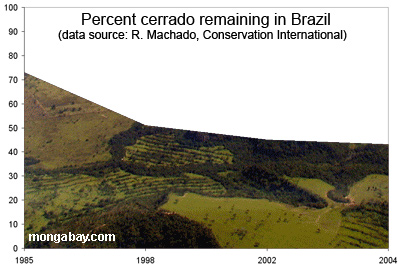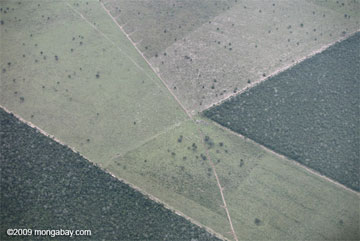Brazil will try to reduce deforestation of the cerrado, a wooded grassland ecosystem in Brazil that is being destroyed twice as fast as the Amazon rainforest, according to the country’s Environment Minister Carlos Minc.
Outlining the new policy Wednesday at the Reuters Alternative Energy Summit in Brasilia, Minc said the government will increase monitoring, create new protected areas, and launch sustainable development projects in the region, which once covered an area half the size of Europe but is fast being transformed into croplands to meet demand for soybeans, sugarcane, and cattle.
“We will make a list of the districts that deforest the most and make specific policies for the districts that destroy 50 percent (of their land areas) in the savannah, as we have done in the Amazon,” Minc said. “And we will launch large operations to battle crime.”
 Biofuels driving destruction of Brazilian cerrado The cerrado, wooded grassland in Brazil that once covered an area half the size of Europe, is fast being transformed into croplands to meet rising demand for soybeans, sugarcane, and cattle. The cerrado is now disappearing more than twice as the rate as the neighboring Amazon rainforest, according to Ricardo Machado, a Brazilian expert on the savanna ecosystem. |
He noted that 120,000 square kilometers (46,000 sq. miles) of cerrado have been cleared in the past six years.
While conversion of the cerrado is often overlooked by environmentalists and authorities due to perceived lack of biological value relative to the Amazon rainforest, the ecosystem is home to more than 10,000 species of plants, 4400 of which are endemic; 935 species of birds; and almost 300 mammal species. Further, recent research indicates that the ecosystem provides important watershed services — serving as the headwaters of many rivers — and plays an integral role in carbon cycling.
Ricardo Machado, author of a 2007 Conservation International study on the cerrado, estimated that the area of cerrado as a percentage of its original 204 million hectares in extent has fallen from around 73 percent in 1985 to around 43 percent in 2004, an annual decline of around 1.1 percent. By comparison, the rainforest in the Brazilian Amazon has diminished by less than 0.5 percent per year over the past decade.
 Clearing of cerrado and transition forest in Mato Grosso for cattle pasture. |
“The Cerrado was pretty much intact until the 60s, when most of the relevant economic activity was the cattle ranching,” Machado told mongabay.com. “During the 70s, when new technologies and new varieties of plants (corn, soybean, rice, wheat, eucalyptus, and grasses for livestock) where introduced the Cerrado became an important region for the Brazilian agribusiness. More and more native areas were cleared to be converted for planted pastures (using African grasses) or croplands. The natural vegetation removed was converted to charcoal to be used by the steel industry.”
Less than 10 percent of the cerrado is presently under any form of protection in Brazil, a substantially smaller proportion than that in the Amazon rainforest.